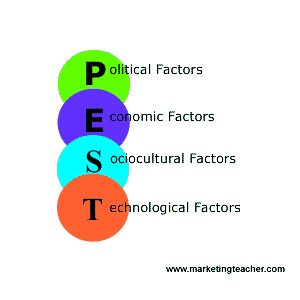PEST analysis
PEST analysis stands for “Political, Economic, Social, and Technological analysis” and describes a framework of macro-environmental factors used in the environmental scanning component of strategic management. Some analysts added Legal and rearranged the mnemonic to SLEPT; inserting Environmental factors expanded it to PESTEL or PESTLE, which is popular in the United Kingdom. The model has recently been further extended to STEEPLE and STEEPLED, adding Ethics and demographic factors. It is a part of the external analysis when conducting a strategic analysis or doing market research, and gives an overview of the different macro-environmental factors that the company has to take into consideration. It is a useful strategic tool for understanding market growth or decline, business position, potential and direction for operations. The growing importance of environmental or ecological factors in the first decade of the 21st century have given rise to green business and encouraged widespread use of an updated version of the PEST framework. STEER analysis systematically considers Socio-cultural, Technological, Economic, Ecological, and Regulatory factors.
Composition
Political factors are how and to what degree a government intervenes in the economy. Specifically, political factors include areas such as tax policy, labor law, environmental law, trade restrictions, tariffs, and political stability. Political factors may also include goods and services which the government wants to provide or be provided (merit goods) and those that the government does not want to be provided (demerit goods or merit bads). Furthermore, governments have great influence on the health, education, and infrastructure of a nation Economic factors include economic growth, interest rates, exchange rates and the inflation rate. These factors have major impacts on how businesses operate and make decisions. For example, interest rates affect a firm’s cost of capital and therefore to what extent a business grows and expands. Exchange rates affect the costs of exporting goods and the supply and price of imported goods in an economy Social factors include the cultural aspects and include health consciousness, population growth rate, age distribution, career attitudes and emphasis on safety. Trends in social factors affect the demand for a company’s products and how that company operates. For example, an aging population may imply a smaller and less-willing workforce (thus increasing the cost of labor). Furthermore, companies may change various management strategies to adapt to these social trends (such as recruiting older workers).
Technological factors include technological aspects such as R&D activity, automation, technology incentives and the rate of technological change. They can determine barriers to entry, minimum efficient production level and influence outsourcing decisions. Furthermore, technological shifts can affect costs, quality, and lead to innovation.
Environmental factors include ecological and environmental aspects such as weather, climate, and climate change, which may especially affect industries such as tourism, farming, and insurance. Furthermore, growing awareness of the potential impacts of climate change is affecting how companies operate and the products they offer, both creating new markets and diminishing or destroying existing ones.
Legal factors include discrimination law, consumer law, antitrust law, employment law, and health and safety law. These factors can affect how a company operates, its costs, and the demand for its products.
Applicability of the Factors
The model’s factors will vary in importance to a given company based on its industry and the goods it produces. For example, consumer and B2B companies tend to be more affected by the social factors, while a global defense contractor would tend to be more affected by political factors. Additionally, factors that are more likely to change in the future or more relevant to a given company will carry greater importance. For example, a company which has borrowed heavily will need to focus more on the economic factors (especially interest rates).
Furthermore, conglomerate companies who produce a wide range of products (such as Sony, Disney, or BP) may find it more useful to analyze one department of its company at a time with the PESTEL model, thus focusing on the specific factors relevant to that one department. A company may also wish to divide factors into geographical relevance, such as local, national, and global (also known as LONGPESTEL).
Use of PEST analysis with other models
The PEST factors, combined with external micro-environmental factors and internal drivers, can be classified as opportunities and threats in a SWOT analysis.
















